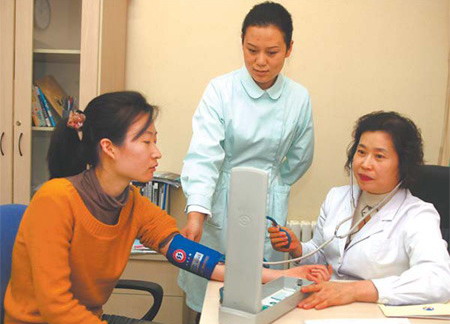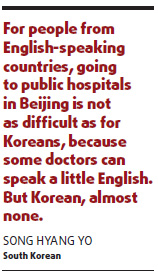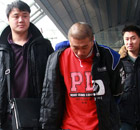Expats
Why Koreans flock to this local clinic
By Yang Wanli (China Daily)
Updated: 2009-12-31 09:36
 |
Large Medium Small |
 South Korean doctor Jin Yinshun (right) measures the blood pressure of a patient at Wangjing New Town Medical Center. [Photo by Wang Jing/China Daily] |
For the past four years, 41-year-old South Korean Song Hyang Yo and her husband rarely visited public hospitals for medical treatment in Beijing. Instead, this couple preferred the clinic near their residential area - Wangjing New Town Medical Center.
Yellow and green colors decorate the walls, floors and ceilings of the clinic, reflecting a similar theme to the hospitals shown in South Korean movies. It is decorated in accordance with Korean hospitals, with Korean signs and magazines filling the waiting room.
According to Huang Ying, medical director of the clinic, the yellow and green walls were specifically chosen to help make the patients feel relaxed and comfortable.
Doctors here speak Korean language and nurses offer a helping hand with medical treatment and language services.
|
||||
For most Koreans, language is one of the biggest problems when visiting the hospital because even if the patient has some Chinese skills, most disease names don't translate from Korean to Chinese.
Chinese names for skin rashes, for example, are divided into several types, each with a different name. But in Korean "there is only one way they know how to put it," said Liu Guizhen, a pediatrician at the clinic, which operates from Monday to Sunday.
Liu has worked in the clinic since it was established in 2007.
At the time, she said, 30 percent of the doctors working there were of Korean nationality or Korean ethnicity. The doctors who could not speak Korean were required to learn the language for one hour every day.
"We've learned the language for daily use and also some basic expressions of some diseases, like having a fever, headache or catching cold," Liu said.
In addition to training the doctors in the language, the clinic provides language guides for foreigners, especially Koreans.
The guides follow the patient through every process of the medical treatment, even going as far as writing down instructions in Korean language on how to take the prescribed medications.
"Communicating in the same language makes the patients feel more safe," said Park Li Young, a language guide working in the medical center.
In one instance, Liu said that a 6-year-old boy had been diagnosed with appendicitis at the medical center. She suggested the boy receive his operation at the Beijing Children's Hospital.
"But due to the language problem, he had to finally go back to South Korea for his operation," she said.
Aside from language, local doctors might also be unfamiliar with the diet, lifestyle and social networks of Korean culture.

This can present a problem when they need to advise patients on making lifestyle changes, Liu said.
In the past 30 years, Liu said most doctors in public hospitals rarely spend more than five minutes with each patient.
But in South Korea, patients are usually given enough time for questions or consulting.
"I spend 30 minutes for one patient in the medical center on average, getting to know why and how they suffered from the disease and explaining the treatment to them," Liu said.
According to Liu, Korean people prefer spicy food and carbonated drinks, which can lead to a stomachache or diarrhea, especially for kids.
A doctor familiar with the Korean lifestyle and diet would have a better frame of reference to diagnose this problem, Liu added.
Roh Tae Kyung, a South Korean dentist in the clinic who has lived in Beijing for seven years, said over the years Wangjing has developed into a bustling area with more than 100,000 Koreans and other foreigners living there.
"Koreans are more concerned about the service and techniques in the clinic," Roh said. "Although the environment here is not as good as that in South Korea, it has been improving rapidly."











